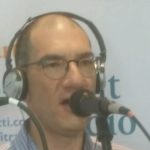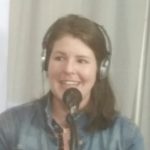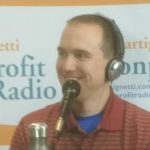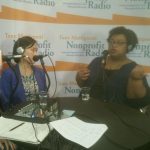
I love our sponsors!
WegnerCPAs. Guiding you. Beyond the numbers.
Cougar Mountain Software: Denali Fund is their complete accounting solution, made for nonprofits. Claim your free 60-day trial.
Turn Two Communications: PR and content for nonprofits. Your story is our mission.
Get Nonprofit Radio insider alerts!
Listen Live or Archive:
- On Fridays at 1pm Eastern: Talking Alternative Radio and tune in
- Listen to the May 22, 2020 archived podcast
My Guests:

Nejeed Kassam: Easy AI
Artificial Intelligence is an opportunity for your career, not a threat to your job. Nejeed Kassam explains how to leverage your skills in a new landscape and describes some of the intelligent tools available for you to work with. He’s CEO of Keela. (Part of our 20NTC coverage)

Tim Sarrantonio: Impact Storytelling
How can technology help you share your impact with the right people at the right time? How do you distill your big story down to a small, comprehensible, individual story? Tim Sarrantonio is with Neon One. (Also part of our 20NTC coverage)
Top Trends. Sound Advice. Lively Conversation.
Board relations. Fundraising. Volunteer management. Prospect research. Legal compliance. Accounting. Finance. Investments. Donor relations. Public relations. Marketing. Technology. Social media.
Every nonprofit struggles with these issues. Big nonprofits hire experts. The other 95% listen to Tony Martignetti Nonprofit Radio. Trusted experts and leading thinkers join me each week to tackle the tough issues. If you have big dreams but a small budget, you have a home at Tony Martignetti Nonprofit Radio.
Get Nonprofit Radio insider alerts!
Sponsored by:
View Full TranscriptProcessed on: 2020-05-22T22:29:33.047Z
S3 bucket containing transcription results: transcript.results
Link to bucket: s3.console.aws.amazon.com/s3/buckets/transcript.results
Path to JSON: 2020…05…490_tony_martignetti_nonprofit_radio_20200522.mp3.89859291.json
Path to text: transcripts/2020/05/490_tony_martignetti_nonprofit_radio_20200522.txt
on Welcome to tony-martignetti non profit radio big non profit ideas for the other 95% on your aptly named host. This marks a month of a dizzy production with audacity and zoom. I’m rather proud of myself. Oh, I’m glad you’re with me. I’d be thrown into Abdur mission if you made me numb with the idea that you missed today’s show. Easy A. I Artificial intelligence is an opportunity for your career, not a threat to your job. Najeeb Qassem explains how to leverage your skills in a new landscape and describe some of the intelligent tools available for you to work with. He’s CEO of Kayla. This is part of our 20 NTC coverage and impact storytelling. How can technology help you share your impact with the right people at the right time? How do you distill your big story down to a small, comprehensible individual story? Tim San Antonio is with neon one that’s also part of our 20 and TC coverage on tony Steak, too. Draw another breath were sponsored by wegner-C.P.As guiding you beyond the numbers wegner-C.P.As dot com by Cougar Mountain Software Denali Fund. Is there complete accounting solution made for nonprofits tony-dot-M.A.-slash-Pursuant Mountain for a free 60 day trial and by turned to communications, PR and content for nonprofits, your story is their mission. Turn hyphen. Two dot ceo. Here is Easy a I Hello and welcome to tony-martignetti non profit radio coverage of 20 NTC. That’s a 2020 non profit technology conference. The conference was canceled, but we’re pursuing it virtually. Yes, they are sponsored at NTC by Cougar Mountain Software Denali Fund. Is there complete accounting solution made for non profits? Tony-dot-M.A.-slash-Pursuant Mountain for a free 60 day trial? My guest now of our second interview of 20 NTC is Najeeb Qassem. He is CEO at tequila. Uh, Majeed. Welcome. [00:02:30.64] spk_1:
Thank you. It’s a real pleasure to be here, tony. Pleasure [00:02:33.14] spk_0:
to have you as well, and I [00:02:54.21] spk_1:
want to correct you. But one thing and TC may have canceled, but the spirit of the conference has not been. There are events popping up all across the continent. Webinars recordings. It’s been I was texting with Amy last night, and I think despite the heartbreak that it’s been, there’s so much community and grassroots support of the folks looking to build capacity and continue their learning, and it’s been heartbreaking, but yet inspiring at the same time. [00:03:02.91] spk_0:
Yeah, well, you jumped into the void, right? Didn’t Didn’t you start put up a page or pages with, uh, virtual webinars that people were gonna be that we’re planning? [00:03:27.71] spk_1:
Yes, sir. Actually, key allies hosting Ah, three day conference called Plugged in. Um, nope. You’re all needed. And Ah, and ah, it’s 99 sessions on different sort of some of the many of the topics. A lot of the speakers from from the intense conference I they’re gonna be speaking on everything from using tech in your social media toe A I and fundraising we’ve got I think five of aunt intends 12 board members are actually speaking. So we’ve had an incredible amount of support from amazing women and men across the U. S. And in Canada to bring people together. [00:03:53.54] spk_0:
Now, when you’re doing this because I’m not sure when this interview you and I are doing right now is gonna air it, maybe after what you’re planning. So [00:04:01.61] spk_1:
it starts today of all things. [00:04:03.19] spk_0:
Okay, You’re definitely It’s not gonna not a [00:04:06.01] spk_1:
big, but it’ll all be recorded as well as if you go to kill a dot com website. I’m sure you’ll be able to find it. [00:04:11.25] spk_0:
OK. K E l a dot com. Yes, sir. Okay. Okay. Cool. Why is there a tennis racket hanging on your wall? Significance there. So [00:04:40.04] spk_1:
it’s funny. It’s wow. Firstly, I had I have a love affair with tennis. I always tell my wife you’re my wife, but tennis is might miss stress. I’ve been playing since the age of three, which is also the time that I’ve been involved in the nonprofit sector. So by two earliest memories are volunteering and hitting a tennis ball. You [00:04:40.24] spk_0:
were volunteering at age three. [00:05:16.84] spk_1:
My mom and dad fled East Africa in the late sixties, early seventies and, uh, they had a rough go growing up and they’re 10. My dad got his first job at 11 to support a bunch of people. My mom had to get scholarships, but they were so supported by civil society and the nonprofit sector. I was born in Canada with, you know, what is the perfect life and so very early my parents taught me and reminded me how important it was to be involved in civil society to build nonprofits, to partake in my community. And so, you know, how do you tell a three year old that you’re not gonna donate to the cause? He’s He’s asking money he’s asking money for And so my mom and that it has refused, right? But I think more. They taught me about how important our sector is and how valuable it is. And so for 30 something years now, I’ve been playing in and around the nonprofit sector, and it’s it’s been a passion of. [00:05:39.03] spk_0:
I should have had Children just so I could bring them along on solicitations. Its strike do. [00:05:43.19] spk_1:
It’s true. I [00:05:55.91] spk_0:
do plan giving, consulting plan, giving fundraising? Yes. If I had a three year old in my lap, I’m now. Could they have been impossible? It’s impossible. It’s better than a therapy dog. I don’t have Children. So I joke about, uh, well, my wife. I love Children. I love chilling. I love all Children, Children of all persuasions and and genders I love all Children know nothing about. Okay, [00:06:09.51] spk_1:
well, you know, I think we’re building all of this for the next generation to write, to make every generation a little bit better and help this generation a lot. A lot, A lot as well. So I forgot to ask you how you holding up in all this craziness [00:06:31.15] spk_0:
when I was gonna ask you Thank you for preempting. Yes, I’m finding in North Carolina, um, safe and well, and I have the ocean across the street, so I can not. [00:06:36.54] spk_1:
The worst thing [00:06:37.54] spk_0:
I can walk on the beach is alone on bits. Find where you and how are you? [00:06:55.34] spk_1:
I’m in Vancouver, BC, and I’ve got the ocean about five minutes away, so I’m blast. My wife is nine months pregnant, so she’s due next week. Um, and so it’s a funny time to be bringing a baby into the world. But they say the 1st 100 days is brutal anyway, so I’m gonna be home, which is a blessing in disguise. [00:07:03.12] spk_0:
Congratulations. We’re recording on March 24th. Are you expecting by the end of this month, [00:07:09.49] spk_1:
Probably early April. I mean, who knows? Now it’s anything that’s two weeks, but it will be exciting. It’ll be [00:07:51.51] spk_0:
right. Let’s talk about artificial intelligence. Your webinar topic, uh, was well sorry. Your workshop topic was on the topic we’re discussing remains easy. Artificial intelligence, simple tools toe tools to elevate your non profit impact. Let’s just start with a basic understanding. What? What what kinds of things were talking about with respect? Artificial intelligence? That’s a wide I was a phrase that could captures everything from manufacturing to big data. What are we talking about? [00:08:23.11] spk_1:
So I think we’re more on that big data spectrum or just the data in general spectrum. So, you know, I’m actually giving the talk at Oculus plugged in in about two hours, so I should hopefully be able to answer this question. Well, you know, we’re talking mainly about machine learning driven, artificial intelligence that’s really part of software. And that’s what I wanted to talk about. How there’s tons of ways that organization, small and big anywhere in the world, can adopt tools some out of the box, some custom built that helped them gain insights, understand, get predictions for their organization on programming, on fundraising, on bullets, your management, whatever it might be on how that’s not some scary, um, mystical kind of thing. It’s a very tangible riel thing that isn’t all that difficult for us to adopt. Even if you’re a tech light, I like myself. [00:09:21.08] spk_0:
It’s time for a break. Wegner-C.P.As. We received RP PP funding. Now what? That’s their latest recorded webinar. What about loan forgiveness? How do you get the max forgiven? Remember, it’s merely forgiveness, not absolution. You go toe wegner-C.P.As dot com, Click Resource is and recorded events. Now back to Easy A I with Najeeb Qassem. Okay, it’s not not easy to adopt and, uh, nineties to adopt and to adapt to also bringing into your daily routine. [00:10:00.54] spk_1:
So, you know, I think it once you make the commitment to make the change, it becomes it’s It’s one of those things. I’m not sure how you lived without especially, you know, And I think so. It is making a change, but not a revolution. It’s about, you know, our thesis and the pieces of the conversation that I was gonna have an NTC was It doesn’t have to up and how you work. It’s not gonna fire people. It’s not going to fundamentally change organization. It’s just gonna make it a little bit easier and a little bit quicker to do some of your work. And so I think part of my responsibility at at in that in that conversation in the webinar I’ll be giving was to say, Don’t freak out of a the A I It doesn’t have to be super expensive. It doesn’t even have to be complicated. But it’s something you’ve got to go out there and be committed to learning about so that you can build capacity at your non. [00:10:19.80] spk_0:
Okay, Well, instead of your saying it there, you’re gonna say it here before you say it again in two hours. So? So you didn’t put the jacket on for non profit radio? The jacket is on for plugged in, right? [00:10:29.18] spk_1:
You know, I put the jacket on no matter what. Definitely for you, tony. [00:10:37.22] spk_0:
Look, now look at me. I’m in a T shirt. Come on. Monday. But I’m on the beach. I’m but I’m [00:10:37.94] spk_1:
a recovering corporate lawyer. This is like, [00:10:40.83] spk_0:
all right. And you recovered a lot more recently that I did. I recovered General Liability melt medical malpractice defense attorney. But that was many years ago. 1990 1994. So you have. When you get further into your recovery, you’ll address you’ll just like this. [00:10:55.84] spk_1:
It I’ll just sort of go from that high a lot of time. That’s all [00:11:09.74] spk_0:
right. It’s incremental. It’s in command. Trust me. Yes, 10 years from now, you’ll stop shaving your wear T shirts every day. Im you 10 years Dennard. [00:12:31.24] spk_1:
Yeah, Yeah. All right. So I think I think the first thing I want to talk about is a little bit about demystifying. What is a I and a at least a I that I’m talking about? Yeah, that I’m talking about is not the robot on TV that takes over humanity. It’s not a piece of technology that can think for itself that can make decisions for itself that can operate. And sometimes I think the perception is artificial intelligence is like I said, this big scary thing The thing I’m talking about is the thing that tells you what song to listen to on Spotify or what products to recommend for you on Amazon. Simply put, it’s it’s taking huge amounts of data and teaching it about ah, developer and engineer. Ah, data scientists will teach it something. It’s like writing an algorithm, right? It’s It’s the same thing we used to have. But instead of just writing the algorithm, if this then that right, it’s it also teaches them how to learn better. Because we know that the more data we have when operated in the right, you know, by the right people. When built properly, they can actually make decision making and better and better. So the a I that we’re talking about the eye that’s built in the Killah and built into tons of other tools sales tools, Amazon, whatever it might be, is simply saying to This is this piece of software that says When David gets in, I’m gonna get smarter and smarter, or it’s gonna get smart and smarter to make that decision or that recommendation or whatever it’s coded to do. It’s a very simple, not simple to build that simple task. [00:12:52.60] spk_0:
Okay, let’s dive in. So can we start with, say, a fundraising application? Absolutely. Well, what? What do you have to offer there? What? [00:12:57.17] spk_1:
So So And I don’t want to talk about kilo here because [00:12:59.76] spk_0:
I know. And I don’t mean not [00:13:00.96] spk_1:
No, no, no. Of course. But, you know, [00:13:02.83] spk_0:
agnostic. What? What could we do with our r c R M database? [00:13:48.78] spk_1:
Absolutely. So So let’s pick something like when a donor is gonna give. Okay? Like you know your your plan. Gift giver. You know, you probably know, you know, the organization to work with probably have years or even decades worth of data, right? They have it. It might be in a spreadsheet. It might be in a CIA ram. It might be, you know, like me on Post it notes. But it’s there. And so that data is, is the It’s the key to making these decisions. So if you know that Tony’s get probably gonna give on giving Tuesday and on December 30th because he’s got tax money, he wants to write off over time. Right now, that’s you. Now you add tens or hundreds or thousands or tens of thousands of donation records for you and for all the other people. What the’s tools could do is start to see patterns and the smart, the A I The machine learning of it is it sees the patterns, and as it gets more data, it the recognition of the pattern gets smarter. Does that Does that make sense? [00:14:12.87] spk_0:
Yeah. All right, [00:14:45.04] spk_1:
so So now I know if I run this through the you know, in my crn if I’ve got this tool later, don or whatever it is that tony is gonna give in these these times and the on the predictions over time over the years over the multiple donors you have are going to get better and better and smarter and smarter and ultimately, more accurate. Now you cannot replace the intuition of a fundraiser. The personal relationships A I tools and the fundraising space are not trying to do that. What they’re trying to do is give you tony a tool to help your work better. [00:15:09.48] spk_0:
Okay. All right. So we need we need a decent amount of data. You know, obviously, the larger the sample, the smart area smarter it is, and the more you could pull out of it, Right? Sorry. All right. So, um okay, so we could predict, um, let’s say bringing into my arena because I’m shellfish. I’m the host planned giving. So I mean, I know from doing this since 1997 that the likelihood that someone is going to be make make a planned gift is based on their They’re giving two factors there giving history, consistency, loyalty, like these are people who now, of course, there are exceptions. But [00:15:35.24] spk_1:
of course, of course. And so that’s what I can’t can’t override, right? You’re 14 right? I mean, sure, they can do it. Agree. But the exceptions or what? Why we need you. This is why you’re not out of a job. At least not yet, right? You know, But but But you’re right. Those two factors, or [00:16:20.50] spk_0:
west, the loyalty of giving. So these are people who have maybe given 25 gifts in 20 years, 18 years or something. 30 givings, 25 years, lots of loyalty, regardless of the gift size and roughly age 55 to 60 over. Yes, some people make planned gifts when they’re 30 something. But again, we’re generalizing. How is ah? So how is artificial intelligence going to help me with that experience based conclusion? [00:16:21.51] spk_1:
So you know what? It might do it And I’m just spitballing here, but you might have a tool that’s built that says that’s able to recognize those factors. And then at a tag or a badge to this ex donor, right? My mom who says, you know, she has the preconditions based on the data we have based on all of your donors, Not just you, all of your donors. These air the patterns. We see these are the preconditions that the developers have sort of said, You know, this is likely. Like you said, history and age and a few other things, and they may run these models is what’s really and then they can say this person is a high likelihood of medium likelihood of low likely. For example, it can spit out a prediction just like Spotify says, If you like Pink Floyd, it might suggest the Zeppelins right. That’s that. It’s this. It’s literally the same logic. It’s It’s a predictions. Okay? An algorithm. [00:17:28.02] spk_0:
I just thought of a way it might actually work alongside. What I just described is, let’s say you’re you know, it’s a statewide organization. It would find the people you tell me if it could probably find the locations. Maybe the county’s sure have a You have a density of planned giving donors or play giving prospects based on who the donors are. But you never realised. You don’t realize there’s a there’s a There’s a greater likelihood for Johnson County to be a plan gift donor than for Smith County, [00:18:50.74] spk_1:
for sure, and I think wanted great things. You know we talk about artificial intelligence as this siloed thing, but it’s actually not. It’s part of any a data or an intelligence strategy in a software or as an organization. It’s not one you know. Software can see stuff that we can’t not just because of the A I because it’s like there’s so much data. There’s only so many records that you conflict there or remember or into it like there’s there’s a whole other ah, bigger right. The reason it can do calculations, fasters. It’s not that it’s smarter than me. It’s just it’s got more processing power than Ideo, and it’s probably smarter than me. But you know, what I’m saying is, and so I think you, you know, you can add the benefit of these things and a good developer, well, actually work with the sector in this case and understand the different preconditions so they might look at location they might look at, You know, the primary things might be age and frequency, but there might be a whole host of other things that determine maybe the stock market, maybe not even example right now. But, you know, maybe the location, maybe the weather who knows. But these factors are then tested on a sample in the development process. What they do is they take the data set in. They carve out a sample, right, like a little bit of it, and they run their models to see if the machine will predict the same things. That the sort of the pure algorithm like, if then kind of stuff. [00:19:33.87] spk_0:
Can we expect if we’re going to the artificial intelligence marketplace to find tools that are already exists? And then we cast we like it’s on a plug in for salesforce or razor’s Edge or something, while majors that you may not allow plugs, but Salesforce would resident probably would not, Um, is something like that is, This is not all custom development, right? [00:19:39.80] spk_1:
No. And that’s really important to note. There are tons of amazing innovators and thinkers and technologists and dedicated, passionate people in the nonprofit sector who are building the stock times. A few on I get to work with a bunch of every day. So here’s where I will say Kayla is a C. R m. We focus on small to medium sized nonprofits, sort of sub 10 year and it’s built right into the tech. So it’s a C R M. But it’s got all this stuff already layered in. There are other tools, like gravity and I wave and other tools a couple of other organizations that lets you plug it into your your sales force or your or your whatever C. R m. And so and they’ve gone out and they’ve analyzed just like we have, you know, and built the factors and work with the sectors and built the technology. So you literally plug in your day that it’s just fresco [00:20:29.04] spk_0:
that was very gracious of you to shout out gravity and I wave [00:20:32.45] spk_1:
No, no, it’s, you know, we’re building something and innovating for the sector together, and I want to make sure that we’re doing what’s best for the sector. And it’s not often I believe it’s kilobit. Often it’s not. [00:20:44.34] spk_0:
What else besides fundraising could give it? Give us another [00:21:05.94] spk_1:
that I want to use a really, really out of a non one that’s got nothing to Akila or I wave or sale sports or anything. I want to talk about suicide prevention. Okay, so there’s an organization in the U. S. That’s that. That worked with data scientists to analyze 65 million text messages across which is heartbreaking by the way to think about the 65 million text messages have been sent in around that, I think it’s called the Crisis text line. The crisis. [00:21:14.58] spk_0:
10 of them. Yeah, they were there, founded by the founder of Do Something. [00:21:19.70] spk_1:
Maybe maybe? Yeah. [00:21:48.41] spk_0:
Forget. Oh, my. I’m embarrassed. I forget her name. You know, the I know are your finger is the current CEO of Do Something but Crisis text line. Yeah, they’re they’re data intensive. Yeah, kids. Sorry, young people Azaz do something became and is now well known in data science and Lewis for people like, you know, like, 16 to 25 or something like that. Or maybe 11 2 25 like that. Yeah, yeah, I know. Crisis took Nancy. Nancy. I forget Nancy. Loveland e. I think Nancy Bubbling. We’re talking about the crisis text line. [00:23:37.24] spk_1:
So crisis text line analysed 65 million text messages on what they were it. So one thing that I learned is that them every minute counts. When you’re talking about suicide, right, the more the quicker you get to the young woman of the young man who struggling that sent the text, the more likely you’re able to help them in time, right? And so what they did is they, You know, the example that I was taught was there’s to exempt to text messages. One. That’s, I don’t know if I could go on. I just want to drive my, um, car off a cliff And the other one is my friend committed suicide. I don’t know how I’m going to get by now. The urgency of those two things is very clear, right? And so, using machine learning, they were able to rank high priority and low priority cases on the high priority cases where they were able. I think there’s something like 50%. They were able to to read out the lower priority ones and get to the high priority ones really quickly. And so something like 90% 90 plus percent of the texts that are high priority as determined by this machine learning algorithm, and that within five minutes they could get to them. They took 65 million text messages, analyze them, built the model that got smarter, that was able to use. Think it’s called natural language processing To say this is high priority. This is lower priority. And because of that, they’re able to save lives. And that’s a really cool example of how our sectors using I Does that make sense? [00:23:42.96] spk_0:
Yeah, of course. Yeah, uh, again, big data. Um, [00:24:05.64] spk_1:
yeah, that one was custom built. A lot of other ones don’t have to be right. That one was cost. Okay. Yeah. Um, one of my engineers actually worked on a data science project in his master’s degree where it was using. And I don’t exactly know much about this one using artificial intelligence and machine learning to help people with prosthetics and getting the nerve movements right, because it was tons of data that they were able to crunch. To say, this is supposed to do this. That’s posted batter. You know, he’s 10 times smarter than I am. But the’s air application, some of them are custom like those and others air out of the box like some of the fundraising ones or chat bots. A really big example. Non. [00:24:26.71] spk_0:
Oh, they are so check box for an example of [00:24:42.64] spk_1:
what you do is you teach they can be. I don’t know if everybody you know you can Great chatbots. And some of them you can just, you know, kind of sign up for and you give up 50 questions or 50 answers. Right? Then people chat in, and as people talk to the bought, it gets smarter and smarter and more able to recognize which crushing it is an answer appropriately, or that it doesn’t know and categorize them and even suggest what questions you should be answering. That’s an example of artificial intelligence. Okay, okay. And not crazy. Not scary. Not take over the world end humanity. Kind of a I just simple. Yeah, you’ve [00:25:14.44] spk_0:
reassured us. Oh, yeah. Okay. Those of those who were words worried in the beginning, um, you want your wonder bullets in your description says, uh, talk about how to leverage your skill set new landscape using working side by side with We’re working with artificial intelligence. That’s not fluid. Like it’s another employee working with it yourself. Well, [00:25:30.52] spk_1:
you know, So I had property. [00:25:32.58] spk_0:
Well, just know what skill sets are are advantageous. [00:26:19.38] spk_1:
You know, I’m in the decades I’ve spent in and around the sector. One thing that I’ve learned is the ingenuity and the commitment of our sector is maybe the biggest and most important resource. And I think the commitment and ingenuity to learn and to continue to grow and drop these tools into our work processes is the most important skill, you know. And sometimes myself included, we’re a little bit rigid, and how we think we’re like this is how we’ve done it for 20 years. Why would I change it? But technology is is whether we like it or not a great disrupter. And this tech is not a fat. It’s not going anywhere. So we need Teoh. It’s not. It’s not difficult to learn, but it it does involve us taking a leap of faith or or getting at least out of our discomfort zones or rather, our comfort zones into our discomfort zones and saying this could be part of my work. The second thing is thinking structurally thinking about this as an opportunity rather than a threat, right? And I think that, you know, I’m disappointed to a degree in how our sector has reacted because this tech has been around its not like its 14 months old, [00:26:54.98] spk_0:
Ondas you said earlier. You know, we’re already taking advantage of it through Amazon products, Absolutely. On Spotify Suggestions are easily see. This is an opportunity, not a threat. Um, but also [00:26:55.61] spk_1:
like the big one, the big guys air using it hard. Just Rocchi’s universities use it for their endowments. They use this, the little guys, the medium organizations. Now that there’s out of the box solutions and other opportunities, you know, that’s great. Like, let’s let’s embrace them. And let’s have the courage to embrace [00:27:29.74] spk_0:
them. All right, we’re gonna leave it there, and that’s that’s a perfect way because our audience is small and mid sized nonprofits, 13,000 weekly listeners so wonderful They’re there, right in your sweet spot as well. Thank you very much. All right. Tony Judaism CEO of tequila Kiva dot com Thank you again. [00:27:31.14] spk_1:
Thanks. Don’t appreciate it. [00:30:08.47] spk_0:
And thank you for being with tony-martignetti non profit radio coverage of 20 and T. C. We need to take a break. Cougar Mountain software. Their accounting product Denali is built for non profits from the ground up so that you get an application that supports the way you work that has the features you need and the exemplary support that understands you. They have a free 60 day trial on the listener landing page at tony-dot-M.A.-slash-Pursuant. Now time for Tony’s Take Jew Draw another breath. No, the ice age is not coming. You just need to take care of yourself. It’s essential. Things are still screwed up badly, and it takes a toll on you. It may feel like it’s more of a routine. Now it is. In fact, it is more of a routine now. But things are still screwed up, and it’s still impinges on the way the way we work and it and it impacts our minds badly. So please put yourself first at some time each day. Maybe it’s total relaxation. Maybe it’s a vigorous workout. I have been saying pure relaxation, which I do, but maybe that’s not it for you on, By the way, I do work out to I’m not a sloth. I’m not even sure what a sloth is. But I’m not a slug, No, but a slug. I’m not sure what a slug is is, um, you know, I don’t crawl around. Um uh, you know what is? Well, I’m not one of those, um Yeah. No, I’m not. That Whatever it is that takes your mind off, work off disease off everything that’s going on around you around, all of us. What is that? Puts you at peace. Find it? You know what it is, you know, think about it. Just got to make time to do it. You know what it is that puts you in peace? Do it. Take care of yourself. Do it each day. You deserve it. You need it. Please. That is Tony’s. Take two. Now it’s time for impact storytelling. Welcome to tony-martignetti non profit radio coverage of 20 NTC. The 2020 non profit Technology Conference. The conference had to be canceled in Baltimore, but we are persevering by Zoom virtually. We’re sponsored at 20 NTC by Cougar Mountain Software Denali Fund. Is there complete accounting solution made for non profits? Tony-dot-M.A.-slash-Pursuant Mountain for a free 60 day trial. My guest kicking off Day two of our coverage is Tim San Antonio. He’s director of strategic partnerships at Neon One. Tim, welcome to the show. [00:30:18.63] spk_2:
Hey, thanks for having me. Thanks. [00:30:20.35] spk_0:
Thank you. I’m glad we could work this out virtually. And you’re well and safe in the Schenectady area upstate New York. I’m glad. [00:30:27.75] spk_2:
Yes, yes. And I’m happy that you’re also doing well. Uh, you know, I am finding it. It’s a trying time for everybody, but I’m also inspired by the creativity that I’m seeing as well. [00:30:56.45] spk_0:
There’s a lot, especially around NTC and and the community commitment to do these virtually whether it’s non profit radio are. Yesterday there was, ah, conference that Ah company called Kilo put together our NTC subset Virtual conference. Kilo did that plugged, and I think they called it. There’s been a lot of community support. We’re resilient. It’s a resilient. It’s a resilient, committed community. [00:31:27.44] spk_2:
Well, and actually, that’s one of the things that that we kind of kicked into. High gear. Neon one is one of the sponsors of the fundraising effectiveness project. Okay, And so that’s Ah, that’s from it was an outgrowth of the Association of Fundraising Professionals, Anderman Institute, in terms of data analysis, and we actually looked back in terms of like what happened in the last crisis, 7 4000 and eight. And we actually found this is a data set that draws from from neon serum, blue meringue donor perfect some other data providers. So it’s very accurate, especially for, you know, small the midsized organizations. [00:31:38.32] spk_0:
That’s our audience here [00:32:27.04] spk_2:
and so, so great. This is this is gonna be relevant because that’s gonna impact us for months, right? Even though we’re talking right now in the midst of the storm, this is not going to go away anytime soon. And what happened in 7 4000 and eight, with the study of about 2400 organizations, is that even when an economic downturn really started to kick in the gear, you know, GDP was dropping and things of that nature donation revenue relatively stayed flat. It didn’t go down that much. Um, and actually small to mid size donations kicked up in the beginning, actually. So? So there is historical precedence. It’s not apples to apples situation, especially with with kind of the social distancing elements here. But, um, if we go back, historically, there is data that shows that we’re resilient. It’s not just kind of like hope is, you know, hope is not a strategy, right? So So you [00:32:34.58] spk_0:
have. And how about after the, uh what do you have data for what happened after the great recession was over 9 4010 [00:33:03.44] spk_2:
Yeah, things have consistently year over year, especially when you start to look at giving institute data alongside of it, which we help supply for think individual giving. But if you look at foundation data, even corporate social responsibility, things go up. Things have historically been going up. The issues are that donor retention is going down. That’s that’s the problem that the larger pie is going up. There’s more money being put into the sector, but individual donor retention has hysterically been kind of taking downward year over year. And that’s that’s the concern that especially a lot of people have with what’s what’s happening right now. [00:33:23.83] spk_0:
I know there is a lot of donor attrition. I’ve had lots of guests talk. About 70 75% of first year donors don’t make a gift. Second year, [00:33:34.04] spk_2:
it’s actually it’s actually a corner pheap. Most recent fundraising effectiveness project data. It’s probably in the eighties at this point when we look at what happened in 2019 and then the fourth quarter report is just about to get announced, so [00:33:53.24] spk_0:
it’s getting worse than getting a guest. Like I said, 70 75. Yeah, all right. [00:33:54.84] spk_2:
And ultimately, I mean that touch. Well, let’s let’s try to shift into the positive tone [00:34:12.06] spk_0:
to the part of what I was gonna shifted into impact storytelling. Which exactly what We’re here to talk about what you were going to talk about MTC. And we’re talking about today standing, standing out in the crowd with impact storytelling. All right, so what do we need to do? Better about [00:34:53.82] spk_2:
what we need to do to do it? Yeah. So ultimately, there’s kind of a lot of different industry theorists and consultants and other thought leaders, you know, talk about an impact feedback loop in the very simple, simple idea there is. When somebody makes a donation, they’re expecting the here report back on the impact of what was done with that. And then there’s data, you know, from people like Adrian, Sergeant and stuff like that that show that the quicker that you tell an effective story to someone on what was done with the money, then they’re more likely to donate again. And so especially way with donor retention going down for first time donors, storytelling is key to engaging those folks and keeping them coming back, [00:34:59.33] spk_0:
Would you say as tell a story as soon as possible? Do you mean within 24 hours you have the donation? Here’s where here’s where your money went. [00:35:07.47] spk_2:
Absolutely absolutely because and now, realistically, because of just how our industry works. And these are things that me on one wants to addresses, is speeding up, getting money into into organizations hands quicker But realistically, like unless it’s like a credit card donation, someone probably isn’t expecting that they’re check where their donor advised fund dispersement or something like that is going to like immediately from day one, like start, start feeding kids or [00:35:37.67] spk_0:
being in the hands of right right being in the hands of beneficiaries, right? [00:37:01.52] spk_2:
Just that’s not realistic. So there’s a little bit of, ah of a you know, gap in terms of what donors we’re gonna understand. But they do know that that there’s a rolling trailing basis of impact that should be happening. People should be doing work every single day that you can talk about right and so so the quicker that you can say, Look, this is what the money that you’ve you’ve put toward is going to do, then the better it’s going to be in terms of your retention rates that there’s there’s just concrete analysis and and and precedents for that type of thing. And so when you’re talking about impact storytelling, the thing that you don’t want to do is four people with statistics, right we could talk about, you know, for instance, just even in this conversation, we can talk about all the different things that people are experiencing right now when it comes to Cove in 19 and and things of that nature. But what we’re doing at me on one, for instance, were actually just about to launch a campaign called N Pose. Rise is focus in on concrete tactical examples of what people are doing to get through this. So examples. Let’s think about the arts world, right? You’re really getting hit because a lot of people’s attention are going toward, you know, health and human service is and food distribution and obviously things that are important. But it’s been fascinating to see organizations in the arts and culture world pivot very quickly the virtual, which they’re not very comfortable with in many ways, right like, If you’re if you’re doing a play or a performance to immediately, then go well. I don’t have the crowd in front of May. What Dough? I dio [00:37:20.24] spk_0:
the only person an actor without an audience. [00:37:35.71] spk_2:
Exactly. And so So to be able to see examples of that where it’s where it’s like one person, Um, one of my favorite organizations locally here is a small art studio that helps kids and it’s called Create Community Studios. And what their executive director start doing is making videos for kids on how to do art. Right? And that’s the thing where, where she’s not sitting there saying like We’ve had such an impact And here’s that, you know, x amount of number that our revenue has dropped right, like That’s not like those things are important to help supplement. But from an impact standpoint, it’s her face saying this is a way that we’re gonna help you if you want to turn around and support. This is how you can do it. But here’s me giving. This is This is the time that we, as organizations, need to give value as opposed to just kind of like provide value and there’s a difference between, like giving with no expectation of return and then like providing an expecting return. And [00:38:48.72] spk_0:
there will be there will be a time for the for the ladder. Yes, on bit’s not in the next week or month, but the time will come when, um especially if you’re keeping in touch with your your supporters, your your donors in ways that you’re describing giving ways if you’re keeping in touch, just explaining. And here we are again storytelling, explaining what’s happening without your hand out. Then when that time is right, your donors gonna think 3/4 expect that there’s there’s been a need and, you know, and how can we? How can we be of help? [00:40:10.37] spk_2:
And there’s there’s concrete in terms of even the psychology of storytelling. Um, uh, it’s interesting in terms of like, there’s been studies done, and we were gonna talk about this in terms of NTC. But But there’s been actual studies done where there’s a difference between, um, basically are you can somebody individually connect with the story that you’re telling because if you tell a story that has too much like it’s to big right, it’s very difficult for us to even think about Cove in 19. On the macro level, right? We hear, like, 200 you know, near 300,000 cases globally. Stuff like that, people kind of tune out. Like, psychologically, there’s there’s been studies that have shown that, like, once you get to, like, really high, big numbers don’t connect this much. And actually, data shows that if you can take the big macro story and then bring it down to here is one individual person or small group of people that have been impacted by this that is when donations actually go up. And so when we were gonna be doing the ah presentation, I was going to focus in on the Syrian crisis because, you hear, you know, refugees. And so you know. And we were gonna actually even show imagery that shows like Think about when you think about the Syrian crisis, what stands out right? And what stands out the images that people remember or not like people in refugee camps. It’s the little boy who lost his life and was washed up right? It’s a little girl who the photographer said, Can you please smile for May and There’s just tears in her eyes, but she is smiling, right? Those are the things that that send chills down people’s spines because it’s just like you and I were having a direct conversation. You know, imagine when you get all the different zoom things, it’s a little bit harder for you to focus in on one like multiple faces in even a meeting or things like that. Where is when you’re having a conversation? You’re building a relationship with someone, and that’s what you’re trying to do virtually as well as when you’re when you’re telling your story. When they’re not actually in the room with you, you know they might be reading a direct mail piece or things of that nature. You want to tell your story where there’s an individual residents because that’s when donations [00:41:09.27] spk_1:
actually go up. [00:41:18.81] spk_0:
Yeah, yeah, that’s consistent with what other guests have said. The macro level is just difficult to combat to comprehend. Okay, okay. [00:41:28.99] spk_2:
And that’s ultimately there’s different strategies that you can do that because you also don’t want to be, especially now seeming opportunistic, right? But [00:41:29.85] spk_0:
yeah, right. But [00:41:30.87] spk_1:
it could be [00:41:41.36] spk_0:
done with sincerity and genuineness and still showing a story revealing an impact without it being you know where your heart on the on your sleeve and with a handout. [00:41:46.30] spk_2:
Now now is the time for [00:41:47.89] spk_0:
the line there There was a line you don’t want across it, because then it looks like you’re being opportunistic. And exploiting the Corona virus for the benefit of your non profit [00:41:57.28] spk_2:
authenticity is what’s going to to help most right now, being vulnerable, being being understanding, you know, like [00:42:06.60] spk_0:
vulnerable is a good. That’s a good adjective. Yeah, [00:42:09.31] spk_2:
it is. It is. I mean, and and for me, you know, it’s it’s difficult even on a personal level, because, like right now in the back of my head, I want to focus on you. But then I’m hearing my Children crying, right, And that’s the reality is that if we understand that that’s happening everywhere. [00:42:25.10] spk_0:
Let’s assure listeners, your wife is home to [00:42:32.97] spk_2:
my wife is home thing. This is not a Lord of the flies situation. My wife is. I [00:42:34.16] spk_0:
want people to know. Yes, [00:43:18.94] spk_2:
yes, so and were trading things off. And she’s an engineer and she has a lot of she’s actually deemed essential by New York state in terms of the work that they’re doing because its data centers that she’s supporting. But at the same time, we want to make sure that our Children are getting, you know, a good continuing an education as much as we can provide them attention. So we’re even picking themes, you know, weekly. So this week’s Dimas is store. It’s fairy tales. So it’s like storytelling, right? So I’m actually even trying to go back to them and and take the concepts that we’re talking about here and and apply that to their own life, right, because they don’t understand what’s happened in their little so. But how can you tell it? In a way, it’s actually purple. It’s going through. This experience is pushing me to be a better storyteller. [00:44:22.45] spk_0:
Time for our last break turn to communications. They’re former journalists so that you get help getting your message through. It is possible to be heard through the Corona virus cacophony. Plus, you want to prepare to build media relationships when the din subsides. Didn’t I love that others with over dinner? It’s just just quick, then in in and at dinner, and it’s just a great word you use the word din. So when they didn’t subsides, you want to be ready to build those media relationships. They know exactly what to do. Let’s turn to. But we may. My, uh, didn’t die. Aggression may have forgotten We’re talking about turned to communications there at turn hyphen two dot ceo. Near the end of this segment, Tim talks about an April 16th virtual conference on giving events. Dream Big Virtual conference Forgiving Day hosts Tow. Watch the recorded conference. Email him Tim at neon one dot com. We’ve got but loads more time for impact storytelling. [00:45:05.66] spk_2:
But everybody’s going through this right. It’s this weird young in collective consciousness that we’re all experiencing and and it’s global. And and And what’s fascinating is that we didn’t have this back in 1918 when you know they influenza situation hit right. Same elements happening there, but we didn’t have all the technology toe help us connect. I don’t know if tony have you seen the mean where it’s like before cove it and it shows everybody just staring at their phone. And then it’s those after Koven is like everybody’s outside. That’s pretty good. It’s pretty good social distance, though 16th [00:45:18.99] spk_0:
in the meantime. What what advice do you have for, Ah, communicating with your institutional funders now and over the next Over the coming months, Way just talked about individual keeping in touch with individual donors. What if you’ve got a grants relationship pre existing? They’ve been funding you. How do you keep in touch with those folks? Is anything different? I mean, I would say institutional funders are made of people. Yeah, but you may have different advice for keeping in touch with whether it’s corporate supporters or private foundation. [00:46:50.58] spk_2:
So and kind of the approach that neon one takes is that that we lean on people with subject matter, expertise and technical expertise because we don’t do everything right. And so what I’ve learned from Flux, which was gonna present with us for the NTC panel, is they focus on Ford Foundation like that’s their client base. So it’s all like private foundations and other institutional partners. And what they’re finding is that, um, one funders air stepping up. There’s a running list of emergency relief funds that we’re seeing because neon one actually does a lot of giving days, for instance, right. And so giving events by community foundations, private foundations or establishing relief funds Giving events are actually having dedicated relief funds and pages for these types of things. And so this is a time to basically don’t shirk away from being honest if you’re in pain. Um, if your organization is experiencing, um, you know, there’s a lot of things when it comes to rent. There’s a lot of things when it comes to paying employees insurance. Um, check what general operational support that you can like ask about general operational support for your institution, [00:46:56.54] spk_0:
maybe even converting an existing grand from something project of programmatic to general operating. [00:47:44.38] spk_2:
Yeah, don’t don’t. I was I got my start as a grant writer, tony, and that was like the first job that I had in the non profit space. And, uh, and this is not the time to focus on non restricted giving That has nothing to do with the immediate needs that your organization needs to distribute. You know, um and so being honest about that and also being prepared to to have difficult conversations around your budget is going to be key to talking to any of these. I will say on the corporate social responsibility side. It’s gonna I think I personally think it’s going to take a bit for that to recover. Now. I did check with our partners over a double the donation, and I said, Have you heard anything about corporations dropping their matching gift programs during this time? No, they have not. So we don’t need to panic. I’m actually seeing more matching gift elements come up, so I definitely lean into those. But you’re probably not gonna be getting a lot of ah, gala sponsorships at this point. Realistically, [00:48:08.82] spk_0:
double the donation. Is that that Adam Adam What? What’s his last name? He was I’ve had him on the show. [00:48:11.89] spk_2:
Why here? I think. [00:48:12.95] spk_0:
Why, wegner? Wine, wine? Yeah, [00:48:20.86] spk_2:
like that. He’s going todo while he’s actually one of the nicest people I’ve ever met. So he’ll be like, Oh, no, this is a supposed to me. You know, Santonio? No, that’s That’s how you say, Uh, yeah, Adam’s. Adam’s great. The team over there is is really great. And actually, Cougar Mountain is neon one part or two. So I’m pretty excited that they’re they’re sponsoring this. [00:48:34.91] spk_0:
Oh, excellent. Yes. There are sponsors 20 NTC. We’re gonna have a booth together. Uh, we’re gonna We’re gonna be in double Booth 10 by 20 together. [00:48:54.47] spk_2:
Yeah. So let let’s go. Actually, let me Let me ask you this. What do you think? The Post Cove it conference world is going to be like, Well, there are for ourselves, [00:49:45.37] spk_0:
Coated. What? I mean, what do you mean, like next year? Yeah, I think there’s gonna be. I think there’s gonna be double the investment in 21 D. C or near double that. There was in 20 and D. C. Yeah. Um, and I some of that is that’s not just my thinking. Some of that is actually quantifiable because I have talked to any sample ward yesterday. You know, then 10 0 yeah. She is a regular contributor on the show she’s on each month. She’s great looking about technology, but on dhe, she’s been on with the show for years, so I know her very well. She said there were. She didn’t know why, but some of the major exhibitors and sponsors had had near double there. Their their support from 2019 to 2020. They were seeing big, some record numbers in sponsorships and support. Um, [00:49:46.26] spk_2:
between We were gonna have a double booth, and actually [00:49:48.42] spk_0:
you were going to Okay, that’s that. That was among a lot of the big sponsors, so it made cancellation that much more difficult. [00:49:56.37] spk_2:
I know. It’s like what, like, 60% of their revenue was anti [00:49:59.93] spk_0:
62 to be exact. Yeah, to pretend the revenue is that conference. [00:50:03.82] spk_2:
Well, they definitely they do have a support fund. I’ve donated to it. For instance, in terms of the even, though my stuff would be covered by neon one. I I personally, uh, made a donation. So folks want to support NTC. I would say this is a good time to [00:50:30.59] spk_0:
radio. Yes, I’ve done the same thing. I made a pledge by April 30th. Yeah, yeah, and 10 dot org’s, but in terms of Well, that s so I just know NTC. I think 21 in D. C is gonna be a blowout. I think I think it’s a mistake. If you don’t exhibit in 21 d c e. I wouldn’t be surprised if they pushed 3000 people where their usual is 24 2500. What [00:50:44.86] spk_2:
I do see happening is supplement, Terry. Virtual events being spun up. So, virtual conferences. We It’s interesting. We actually [00:50:52.02] spk_0:
amorphous gave that. I am I narrowed down to one. I only know in D C. You’re able to look global. Uh, all right, well, that’s why that’s why we’re picking your brain, you [00:50:57.17] spk_2:
know? And that’s part of my job is to pay attention, [00:51:03.84] spk_0:
wegner. Thank you. All right. Despite its strategic sponsorships, I’m a little leak in fundraising Consultant in podcaster. [00:51:06.93] spk_2:
But I love it. I love the podcast, tony, Thank you into every year. [00:51:19.82] spk_0:
Yes, Podcasts have a place, especially now. But, you know, I’ve been at this for 10 years. July is gonna be our 500 show, so you should jump on the sponsorship bandwagon and [00:51:19.97] spk_2:
I’ll talk to marketing. I’ll talk to talk to our marketing. [00:51:26.30] spk_0:
Okay. Um yeah. Cougar Mountain is already on. Um okay, so that go back to what you were saying? What you expect to see we’re [00:53:39.84] spk_2:
going to see more. So a MP, for instance, they they’ve created So NTC has done community submission. So, you know, for instance, Dion, one is doing ah, Siris of Webinars and things of that nature specific. Teoh Cove in 19. Um, you know, virtual events, virtual galas, that type of situation. We have some interesting things around, live streaming with our partners That tilt if I, for instance, you know, silent auctions with click bid, Um, on then all of this needing to go back to a database of records so you can cultivate that relationship. But it’s also interesting to see what a f P has done, which is that they association fundraising professionals. Basically, that was going to back to back Ah, this week. So, you know, my wife was gonna hate the the fact that, um, you know, I was gonna be gone for a week, But be careful what you wish for, I guess in terms of my wife, um So if he’s done a full virtual conference and I think we’re going to see more and more of those supplementary things because even if you can get thousands of people in one space, which we will, that will happen again once once, you know it’s going to take months, but it’s gonna happen. I do still think from an equity standpoint that virtual conferences are, uh, are going to start popping up mawr as Look, you can’t make the physical thing, then come to our virtual conference. And I think we’re going to see more and more of that not only from an equity standpoint, inaccessibility standpoint, but just because it’s good business as well. Um, I mean, we’re spitting up our first virtual conference, and we actually planned it months before any of this happened. But, um uh, you know, it’s in April, April 16th and it’s gonna be on giving events, you know, 1st 1st virtual conference ever on forgiving event hosts. You know, if you want to run a giving day for your college, for your community, um, you know, we said, Hey, let’s start now, do it. But we had to shift the tone. You know, we had to shift some of the sessions, obviously. Ah, but what What’s actually encouraging is the data that we’re seeing is that we’re seeing massive spikes in people starting to pre pre donate or donate forgiving events. So the idea of giving vent think like giving Tuesday, right? Everybody goes to one site they donate to the community. We’re actually seeing a lot of this stuff go up very encouraging numbers when it comes to online donations popping up [00:53:53.58] spk_0:
before before the actual day. [00:53:55.61] spk_2:
Yes, yeah, so we’ve we’ve opened up the days Ah Teoh do early registration and stuff like that because And actually, what’s interesting is that Arizona gives, for instance, which is, I think, April 11th this year they had about 720 organizations log on and register for the platform there, almost 1000 at this point. So more and more non profits are saying you know what we want. We want to invest in and work with our community, and that’s it’s a rising tides situation. So giving events, if there’s one in your community join it doesn’t matter if it’s neon one or whatever, just do it because it’s gonna get a lot more attention this year [00:54:33.60] spk_0:
and we gotta wrap up so I could stay on schedule. Let’s give a shout out to your what do you have coming up in April and where, where people go to find out about on April what 16th? [00:54:41.44] spk_2:
Yes, April 16th and we have a ton of resource is that we’re rolling out over the course of the next few weeks, including Ah, you know, just go tony on one dot com and we’re gonna have a dedicated page just for all of some rapid response resource is to get funds into nonprofits hands quicker. That is what we need right now because then they can tell their story better. So that’s what we’re gonna be doing. [00:55:08.39] spk_0:
I want to compliment you on being coordinated between your T shirt and that portrait on your say that is that portrait on the wall in red and black [00:55:11.22] spk_2:
that is shaken Avara [00:57:15.85] spk_0:
of our Congratulations on your coordination. Thank you. He’s Tim San Antonio director, Strategic partnerships at Neon one. Thank you very much, Tim. Thank you. And thank you for being with tony-martignetti non profit radio coverage of 20 NTC, as we mentioned. Sponsored at 20 NTC by Cougar Math and Software Denali Fund. Is there complete accounting solution? Thank you for that Thumbs up. All right. Made for non profits made for non profits. It’s great. Tony-dot-M.A.-slash-Pursuant Mountain for 40 free 60 day trial. Thanks so much reading with us next week. Lawrence Paige No Ni returns with his new book, Fundraising 401 I wonder if he’s inspired by Fahrenheit 911 and I still wish you would pronounce his name Panyu. Tony, I have not forgotten that if you missed any part of today’s show, I beseech you, find it on tony-martignetti dot com. I’m gonna challenge him with that Panyu tony. Maybe I don’t have done that before, but he can count on it again were sponsored by wegner-C.P.As guiding you beyond the numbers. Wegner-C.P.As dot com by Cougar Mountain Software Denali Fund Is there complete accounting solution made for nonprofits tony-dot-M.A.-slash-Pursuant Mountain for a free 60 day trial and by turned to communications, PR and content for you non for non profits. Your story is their mission. Turn hyphen two dot ceo Ah, creative producer is clear, Meyerhoff. I did the post production Sam Liebowitz managed extremely shows Social Media is by Susan Chavez Mark Silverman is our Web guy and this music is by Scots. They’re with me next week for non profit radio big non profit ideas for the other 95% Go out and be great talking alternative radio 24 hours a day.








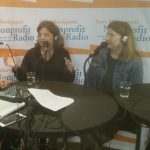 We talk through the issues encountered when managing remote staff: technological; generational; emotional; measurement; recruiting and retaining. Our panel is Heather Martin from
We talk through the issues encountered when managing remote staff: technological; generational; emotional; measurement; recruiting and retaining. Our panel is Heather Martin from 

